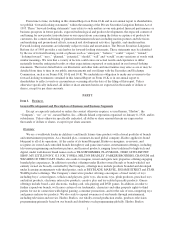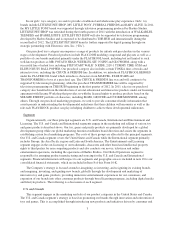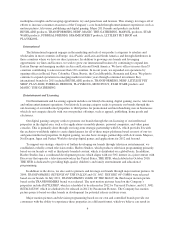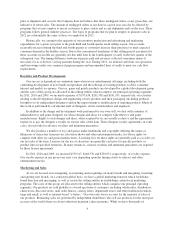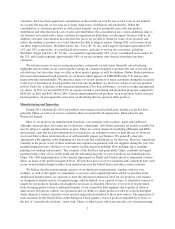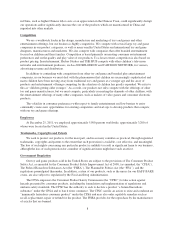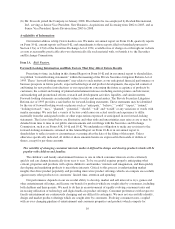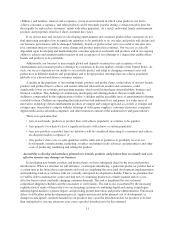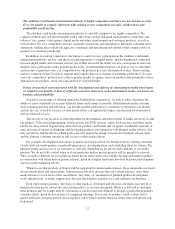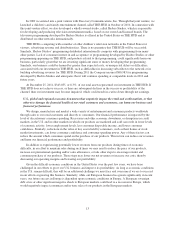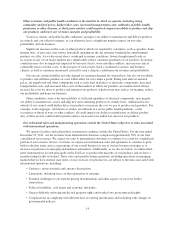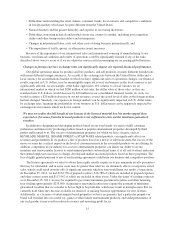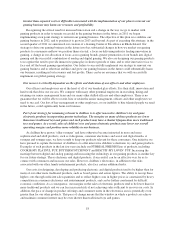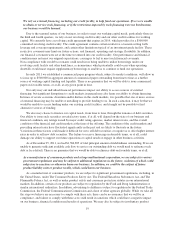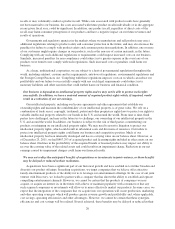Hasbro 2011 Annual Report Download - page 20
Download and view the complete annual report
Please find page 20 of the 2011 Hasbro annual report below. You can navigate through the pages in the report by either clicking on the pages listed below, or by using the keyword search tool below to find specific information within the annual report.children’s and families’ interest and acceptance, create an environment in which some products can fail to
achieve consumer acceptance, and other products can be extremely popular during a certain period in time but
then rapidly be replaced in consumers’ minds with other properties. As a result, individual family entertainment
products and properties often have short consumer life cycles.
If we devote time and resources to developing entertainment and consumer products that consumers do not
find interesting enough to buy in significant quantities to be profitable to us, our sales and profits will decline and
our business performance will be damaged. Similarly, brands or products that were successful at one time may
lose consumer interest over time as tastes change and product innovation continues. Our success is critically
dependent upon developing and maintaining the consumer appeal of our brands and products and in our ongoing
ability to achieve and maintain market interest in and acceptance of our offerings to a degree that enables those
brands and products to be profitable.
Additionally, our business is increasingly global and depends on interest in and acceptance of our
entertainment and consumer product offerings by consumers in diverse markets outside of the United States. As
such, our success depends on our ability to successfully predict and adapt to changing consumer tastes and
preferences in different markets and geographies and to design product offerings that can achieve popularity
globally over a broad and diverse consumer audience.
A decline in the popularity of our existing brands, products and product lines, or the failure of our new brands,
products and product lines to achieve and sustain sufficient interest from retailers and consumers, could
significantly lower our revenues and operating margins, which would in turn harm our profitability, business and
financial condition. The challenge of continuously developing and offering products that are sought after by
children is compounded by the sophistication of today’s children and the incredible array of entertainment offerings
available to them. Children are expanding their interests beyond traditional toys and games to a wider array of
innovative, technology driven entertainment products at younger and younger ages and, as a result, at younger and
younger ages, our products compete with the offerings of video game suppliers, consumer electronics companies,
digital media and social media companies, and other businesses outside of the traditional toy and game industry.
There is no guarantee that:
• Any of our brands, products or product lines will achieve popularity or continue to be popular;
• Any property for which we have a significant license will achieve or sustain popularity;
• Any new products or product lines we introduce will be considered interesting to consumers and achieve
an adequate market acceptance; or
• Any product’s life cycle or sales quantities will be sufficient to permit us to profitably recover our
development, manufacturing, marketing, royalties (including royalty advances and guarantees) and other
costs of producing, marketing and selling the product.
An inability to develop and introduce planned new brands, products and product lines in a timely and cost-
effective manner may damage our business.
In developing new brands, products and product lines, we have anticipated dates for the associated product
introductions. When we state that we will introduce, or anticipate introducing, a particular product or product line at
a certain time in the future those expectations are based on completing the associated development, implementation,
and marketing work in accordance with our currently anticipated development schedule. There is no guarantee that
we will be able to manufacture, source and ship new or continuing products in a timely manner and on a cost-
effective basis to meet constantly changing consumer demands. This risk is heightened by our customers’
compressed shipping schedules and the seasonality of our business. The risk is also exacerbated by the increasing
sophistication of many of the products we are designing, in terms of combining digital and analog technologies,
utilizing digital media to a greater degree, and providing greater innovation and product differentiation. Unforeseen
delays or difficulties in the development process, significant increases in the planned cost of development, or
changes in anticipated consumer demand for our products may cause the introduction date for products to be later
than anticipated or, in some situations, may cause a product introduction to be discontinued.
11


